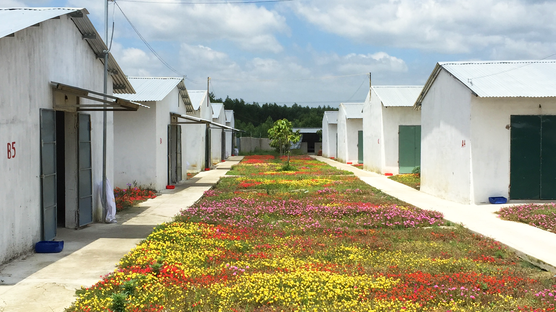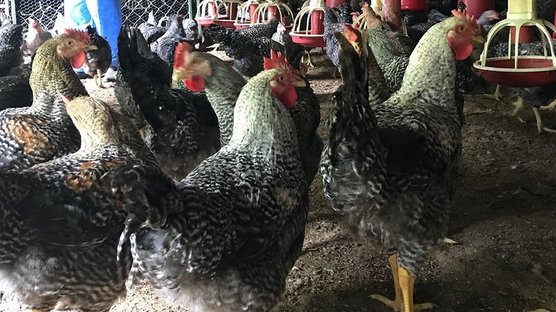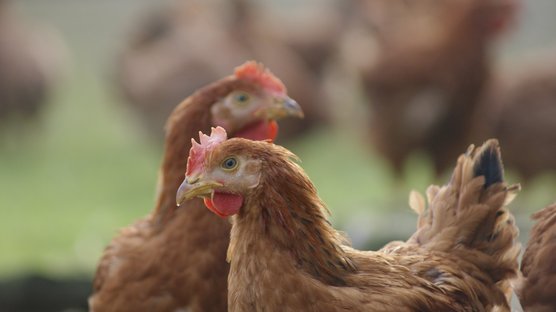
Published on March 19, 2021
Homogeneity and eggs weight
As a colored chicken breeding company, we must respond positively to the needs of the markets by offering products with good feed conversion rates, yields, and above all, uniformity. We must also meet the expectations of our direct customers, by offering them high performance and profitable breeders for their company.
Indeed, the profitability of a batch of female breeders shows its capacity to produce a maximum of high-quality hatching eggs of good size and of sufficient homogeneity. These last two traits will ensure the quality of the broiler chick flock, the growth performance until slaughter, and the profitability of the final product flock. Our breeding programs and our range of products allow us to satisfy a wide range of customers.
Hatching egg production, size and homogeneity of the eggs depend on two different parameters: a genetic variable on which we base ourselves to present the potential on the field of the breeders, and an environmental variable that we can more or less control, such as building equipment, different management techniques, feed presentation and formula, bird health, environment, climate conditions etc. This is why our standard performance may be more or less than the real performance of the batch. This also means that it is possible to influence egg laying performance, size and homogeneity of the eggs following a specific technical and/or nutritional management. Some decisions have to take place during the rearing period, as this period will directly influence the egg laying and egg weight performance during the whole production period in an efficient and profitable way. Good management in production time and also nutritional and feed presentation factors can then help to achieve the wished goals in a short term.
It is important to note that the traits of egg laying, and egg size are negatively correlated. A specific management will therefore allow to improve one trait, in spite of the other: this will reflect the strategic decision of the company. Indeed, we can specify here that a hen lays a mass of eggs, and not a number of eggs: the larger the eggs, the fewer eggs there will be in the end. Ideally, we will naturally seek to have a rise in egg size quickly to have hatching eggs of good quality, then a stabilization of the egg weight once the objective is reached, to maximize the number of total eggs hatched. Too much evolution in egg weight over the entire production period could have many negative effects on eggshell quality (and therefore hatchability), and on the quality of the chicks hatched.
In the following, we will focus on the size and homogeneity of the eggs.
Rearing period and management of female breeders.
One of the most important parameters to control egg size and uniformity is the weight of the female breeder at sexual maturity along with the overall uniformity of the batch. Females above the curve in terms of bodyweight will lay large eggs, while lighter hens will lay smaller eggs. Finally, a homogeneous flock will tend to produce eggs of more uniform size, regardless of genetics. This makes it easier to manage production and improve performance in terms of laying persistence and viability of female breeders. Finally, it should be noted that egg weight uniformity is a very weak heritable trait, which means that the environmental part is key.
To control the weight and the homogeneity of the females, we strongly recommend performing a grading of the hens as soon as possible to separate them by weight categories. This technique allows the ability to manage differently the batches during all the rearing period to bring them to a target weight (more or less heavy compared to the standard) and to obtain at sexual maturity a very homogeneous flock. Ideally, we advise to do it from the second week of age to see positive effects on the size (female weight) and the homogeneity of the eggs and the day-old chicks (female homogeneity). This grading is then done on a daily basis to ensure that the groups are always homogeneous. It is essential to have a weekly follow-up of the average weight of the breeder female, until the peak of laying, to be able to adjust its management and to be closer to the objectives. Remember that the first 10 weeks of age are essential for future breeders to develop a good skeleton and ensure good performance. An unbalanced skeleton will not reach the performance potential, even with a good technical management.
The lighting program is essential to control and direct the age of sexual maturity and weight. Remember that the lengthening of the days in spring naturally trigger the laying of the hens. It is therefore possible to bring forward or delay the hens in laying according to the strategy of different lighting programs. An earlier start of laying will result in more hatching eggs, but with average size below the standard. On the opposite, a late start will allow to obtain larger hatching eggs from the beginning but will decrease the total number of eggs laid. The lighting program profiles can therefore vary: a light program that is slower to reach the plateau light duration will favor the females’ growth, reaching higher bodyweights while delaying sexual maturity.
We recommend a visit at 17 weeks of age in all cases, to define the maturity of the hens and to make a decision about light stimulation. Before the light stimulation or the transfer to the production building, remember to prepare the ovaries by progressively extending the duration of water available during the day (if the birds are rationing).
Finally, it is essential to work on the crop of the females from the fourth week of age by switching to a 5/7 feeding program to help the important feed intake at the start of laying. This method allows the hens to ingest progressively larger quantities of feed than they would have naturally had in 7/7 and thus, to get the crop used to it. At a certain age, SASSO females consume the feed ration very quickly: it is not necessary to feed before switching off the lights to make the 5/7 method effective. Just make sure that every bird has enough space to eat at any age to ensure a good uniformity of the flock by the right feed intake: it is necessary to adapt the space available according to the feeding equipment. In the same way, the presentation and the granulometry of the food are key to allow a balanced ingestion of all the essential nutrients, by all of the birds.
This ingestion capacity and the speed of the feed increased at the beginning of the laying period will directly influence the egg size. A quick increase of feed ration per day will allow to obtain large size eggs more quickly. It is then important to proceed with reduction of feed rations as soon as the peak of laying is reached. We recommend removing 1g of feed/hen for every gram of egg weight taken.
Nutrition
Finally, the feed formulation will help to obtain an adequate egg size. Many different studies have shown the essential role of amino acids on the evolution of egg weight. The concentration of lysine, methionine and cystine in the feed is positively correlated with egg weight. We also know that methionine and cysteine have a buffering effect on egg weight, i.e. egg weight does not increase after a certain concentration of methionine and cystine. Therefore, we can adjust the egg weight with the amino acid concentrations. There is also a positive correlation between crude fat and linoleic acids and egg size.
However, it is necessary to get in touch with nutritionists and feed companies to deal with this subject. Indeed, the dietary balance must be respected at all levels, and at all ages according to the total egg production and the objectives. The effects can be important.
Don't hesitate to contact your SASSO technical advisor before setting up your flock to discuss what is the right strategy to adopt. Remember that the period from 0 to 20 weeks is key to obtain a successful flock, and that the growth and uniformity profiles at key ages should not be neglected. The effects on egg weight and uniformity performance will be directly correlated.
Contact us :
Africa | Europe | North America | Asia




